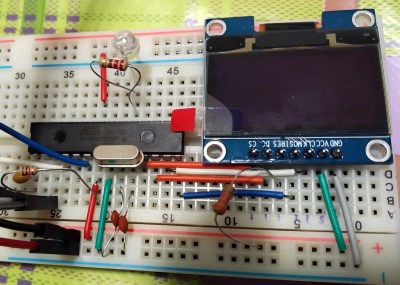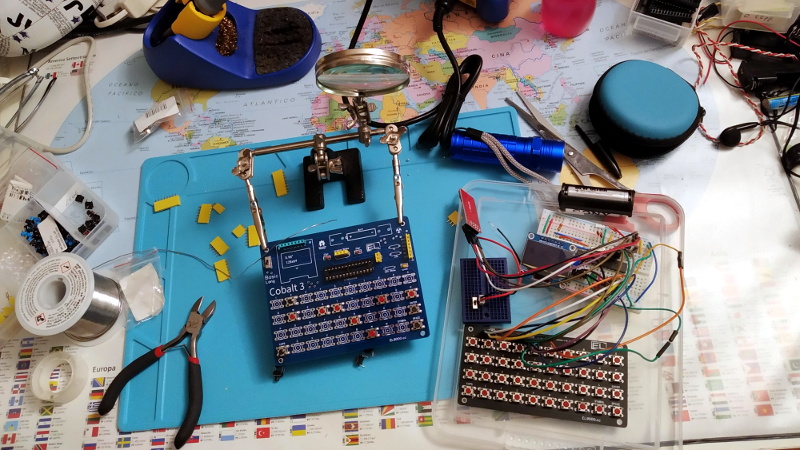Not satisfied with any of the DIY retro computer kits on the market, [Leonardo Leoni] decided to make his own. Built using only the finest through-hole technology and powered by the ATmega328 microcontroller, his diminutive 8-bit computer is easy to build and even easier to develop for. Whether you’re looking to hone your BASIC skills or play some Zork on the bus, this little computer looks like a great project for anyone who has a soft spot for computing’s simpler days.
 All things considered, using this tiny machine looks like it would be relatively pleasant. [Leonardo] is using a common SH1106 OLED display, and there’s a full QWERTY keyboard (with number row) done up with tactile momentary buttons. There’s very few passive components involved in the build, which is sure to be appealing to new players; especially after they’ve finished soldering all those switches to the board.
All things considered, using this tiny machine looks like it would be relatively pleasant. [Leonardo] is using a common SH1106 OLED display, and there’s a full QWERTY keyboard (with number row) done up with tactile momentary buttons. There’s very few passive components involved in the build, which is sure to be appealing to new players; especially after they’ve finished soldering all those switches to the board.
On the software side, [Leonardo] says he leaned heavily on open source projects to get his machine up and running. Beyond the hardware drivers for things like the display, he specifically calls out the Tiny Basic and Tiny Lisp Computer projects for their code. If small-scale programming isn’t your style, the machine is compatible with the Arduino IDE so you can easily throw something else on it. If you’ve ever dreamed of a QWERTY Arduboy, this might be your chance.
From the way [Leonardo] describes the computer, which he calls the Cobalt 3, we get the impression a commercial kit might be in the cards. We hope the community shows enough interest to make it happen. After all, not everyone was able to make it to Hackaday Belgrade 2018 to get their own pocket retro computer.
















Diminutive.
“we get the impression a commercial kit might be in the cards”
Out of stock.
https://www.tindie.com/products/el9000/cobalt-3-a-pocket-computer-diy/
That looks quiet neat –
Well, “quiet” depends on how clicky the buttons are…
B^)
Meybe install this computer inside cheap keyboard
I well remember the 1970s when ATmegas were found largely in universities and cost several thousand dollars. This really takes me back.
??? In the 70s??? AFAIK the first AVR (ATmega) was introduced in 1997…
First half of the 70s, your options for off the shelf computer control of anything were machines like the “miraculously cheap, first under $10000” PDP-8/S minicomputers, taking up only the area of a filing cabinet. So began adventures in small scale computer control, “X with a computer” applications. With a few kilobytes of RAM, about the same I/O capabilities and considerably less powerful at under a MIP, vs 1 MIP per Mhz of the AVR, they were the rough equivalent of the arduino in the day. 4004 and 8008 were just out but were a bit bleeding edge at the time to consider doing serious stuff with, that snowball began to roll though and gathered speed from mid 70s
The 1970’s equivalent of the ATmega was the PDP11. Virtually the same speed, used for the same tasks.
Yes, small and portable and fits in your pocket – our beloved PDP11 :-) Just like a microcontroller :D
Here’s your little PDP11: https://www.instructables.com/id/PiDP-11-Replica-of-the-1970s-PDP-1170/
I think there’s a Doom port for the Arduino. Would be nice to see it on here.
fpga (like fomu) will be great
Its no ZX81. Should be faster though. Maybe. Would be nice to be able to store massive 1.2KB programs in a nice SPI/TWI Flash. BASIC is such a piggy that less than 8KB RAM kinda sucks. No cassette drive or RCA jack modulated video. How sad. Oh I know what it needs.: A 6- 8in cheap fresnel lens so can read it. Better than ol NTSC on a 12″ B&W TV.